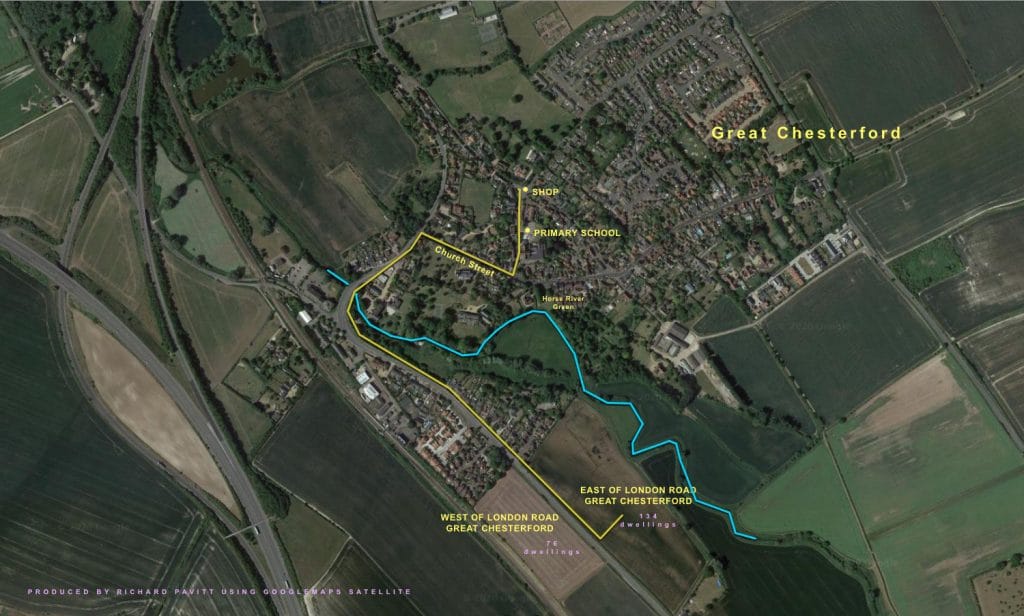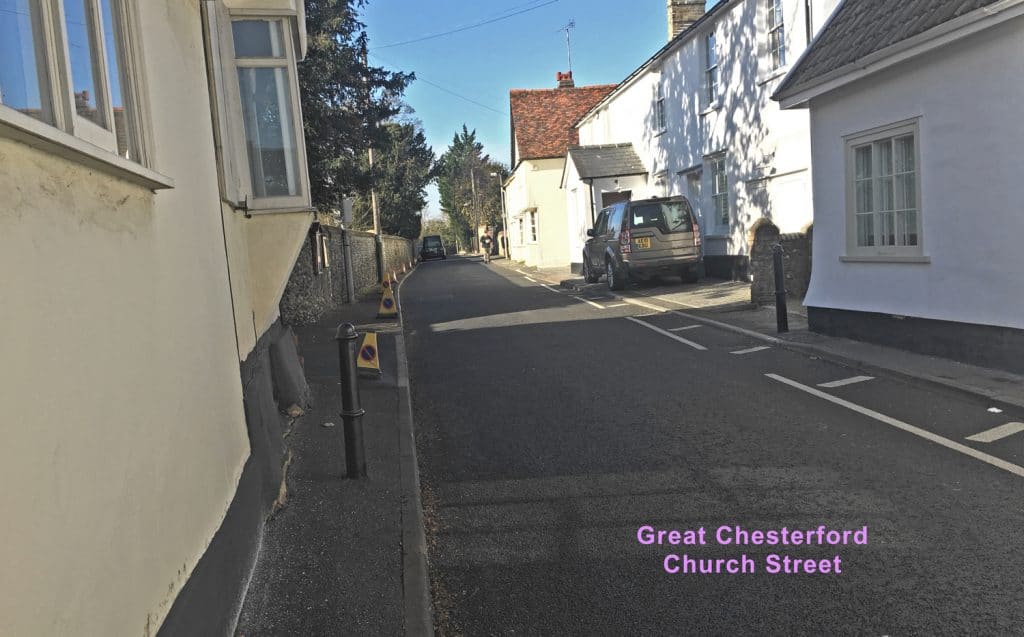A planning application has been made to build up to 134 houses on the eastern side of London Road, next to Granta Close and opposite the site where permission has already been granted for 76 houses. The two developments will result in an 18 percent increase of housing in Great Chesterford.
Maintaining a supply of new houses is important but growth should be organic and proportionate. Application UTT/20/2724/OP “land east of London Road” has serious implications. We have to question whether this is sustainable development. Here are some key concerns (in no particular order):
Traffic and Impact on village centre:
This development sits on a busy road (B1383). To walk or cycle to the village centre is roughly 1km (see the satellite image below). There is no formal cycle path. Car, cycle and foot traffic entering the village converges on Church Street, a narrow lane, which for most of its length does not have useable pavements. Pedestrians have to walk in the road and those with a pram, or using a mobility scooter or wheelchair, are particularly exposed.
Without a new direct foot and cycle access into the village to enable people to safely walk and cycle, these new developments (this one of 134 units plus the 76 recently approved, totalling 210 dwellings) will generate excessive additional car journeys for school trips, doctors visits, and access to the shop and pubs, through narrow streets and without any formal car parking.
The B1383 is a through road, a diversion route when the motorway is closed and is frequently the scene of speeding. This presents very real dangers when school buses collect and drop-off secondary school pupils.
Water/River/Sewage:
The groundwater in this area is rated “high risk” – that’s because the Chalk aquifer is closes to the surface. Not only is the aquifer the principle source of drinking water for Uttlesford and South Cambs and therefore should be protected from contamination, it is also at an historically low level. This raises a question: can water be sustainably supplied to these new houses without further depleting the aquifer and therefore harming the sensitive ecology of the area’s chalk streams? The site slopes towards the river Cam, which as a chalk stream is highly sensitive to pollution.
The sewage treatment works at Great Chesterford is said to have capacity for the outflow of an additional 200+ houses, but is the network adequate? Modestly heavy rainfall has at times caused sewage flooding in the grounds adjacent to the Community Centre and in the gardens of Bishops House. Adding the outflow of 200+ houses (bearing in mind climate change is increasing the frequency of heavy downpours) will likely increase this occurrence.
Recreation and amenity space:
These proposed new houses are farthest from the village recreation facilities and allotments (c.1.5km). This means the likelihood of considerably increased car journeys and strain on Community Centre car parking.
Primary school and doctors surgery:
Following recent housing developments both are already at or close to capacity and are creating traffic and parking issues both at peak times and throughout school hours.
Landscape:
The site sits within a visible part of the Cam river valley, close to regularly used footpaths and nature trails. There are good reasons not to build in such a location and at the very least will require careful site landscaping and planting to minimise impact.
Emerging neighbourhood plan:
This site (denoted Chest 8 in the draft neighbourhood plan) has not been selected for inclusion in the Great Chesterford Neighbourhood Plan. It is considered the site does not positively contribute to the plan’s vision of organic and proportional growth, nor will it promote and enhance the area’s distinctive characteristics, shared resources, rural feel and inclusive community.




The B1383 is already a busy road and when there is a problem on the M11 which is regularly it becomes so busy people in the next village of Littlebury cannot get out of their turnings.Chesterford is a small village that has already had several developments built ,it has a small school,a small shop,a small doctors surgery it really will not cope with another 200 plus houses,please leave it as a desirable village to live in,if new homes must be built build them near larger towns where town people want to live.
I would like to say a couple things. I have lived in Chesterford for 21 years. Its ridiculous that these developments are even being considered. The traffic issue will be a major issue and schools and GP surgeries are under immense presure with the influx of new potential residents. Also some of the recent developments are not affordable housing . How can you justify that for first time buyers? Last point here. Great Chesterford is a village not a town. Please leave it that.
Very concerned at this latest development and this could be one of several other similarly sized developments around Great Chesterford.
In view of the threat to the endangered chalk stream ecology of the river Cam even posed by existing water use and sewage outflow in the area, I would welcome an immediate requirement from UDC that any new housing should include systems for recycling their grey water and in general that all new housing should embody the best in green design. Even adding that to the design brief would not mean that this proposed development was sustainable for the village for the reasons given above on increased car traffic, lack of safe pedestrian access and the capacity of local facilities (in particular the school).